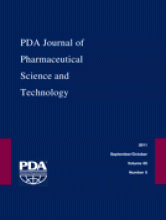Abstract
Pre-filled syringes/cartridges as primary packaging for parenterally delivered biopharmaceutical liquids consist of multiple components, including containers made of glass or plastic, and stoppers/plungers and disk seals (septa) made of rubber materials. Cracking of rubber components may be cosmetically unacceptable and in extreme cases may compromise enclosure integrity. The purpose of this study was to investigate the root cause of septum cracking and evaluate parameters/solutions to delay or prevent cracking from occurring. Custom-made chambers capable of tightly controlling ozone levels were assembled to deliberately create septum cracks. Cracks were qualitatively assessed by optical microscopy and quantified using image analysis by ImageJ. The results confirmed that ozone attack is the root cause of septum cracking during storage, and the stress—the result of crimping on the glass cartridge by the aluminum lined seal—made the septum particularly vulnerable to ozone attack. Ozone concentration as low as 10–40 ppb (levels routinely detected on a busy street) could crack the stressed septum in hours while days of ozone exposure at 50 ppm could not cause the unstressed septum to crack. Under ozone attack cracks initially grow in length and width uniformly across the stressed area and then stop progressing, perhaps due to residual stress release. Although the use of impermeable barriers could prevent cracking completely, this study suggested that any form of packaging barriers, including a highly permeable Tyvek® sheet, could postpone cracking by slowing down ozone diffusion and convection. We demonstrate that simple double packaging—placing the Tyvek®-lidded blister tray in a cardboard carton—could sufficiently protect the stressed septum for years in a surrounding environment with ozone at normal indoor levels (≤2 ppb).
LAY ABSTRACT: Pre-filled syringes/cartridges as primary packaging for parenterally delivered biopharmaceutical liquids contain multiple components, including a disk seal (septum) made of rubber materials. Cracking of rubber components may be cosmetically unacceptable and in extreme cases may compromise enclosure integrity. The septum, if not appropriately packaged, might crack under uncontrolled storage environment. The purpose of this study was to investigate the root cause of septum cracking and evaluate parameters/solutions to delay or prevent cracking from occurring. Custom-made chambers capable of tightly controlling ozone levels were assembled to deliberately create septum cracks. The results confirmed that ozone attack is the root cause of septum cracking during storage, and the stress—the result of crimping on the glass cartridge by the aluminum lined seal—made the septum particularly vulnerable to ozone attack. Ozone concentration as low as 10–40 ppb (levels routinely detected on a busy street) could crack the stressed septum in hours. Although the use of impermeable barriers could prevent cracking completely, this study suggested that any form of packaging barriers, including a highly permeable Tyvek® sheet, could postpone cracking by slowing down ozone diffusion and convection. This investigation will raise awareness of manufacturers of pre-filled cartridge/syringe parenteral products to storage and packaging requirements for the long-term physical stability of cartridge components as small as the rubber septum.
- © PDA, Inc. 2011
PDA members receive access to all articles published in the current year and previous volume year. Institutional subscribers received access to all content. Log in below to receive access to this article if you are either of these.
If you are neither or you are a PDA member trying to access an article outside of your membership license, then you must purchase access to this article (below). If you do not have a username or password for JPST, you will be required to create an account prior to purchasing.
Full issue PDFs are for PDA members only.
Note to pda.org users
The PDA and PDA bookstore websites (www.pda.org and www.pda.org/bookstore) are separate websites from the PDA JPST website. When you first join PDA, your initial UserID and Password are sent to HighWirePress to create your PDA JPST account. Subsequent UserrID and Password changes required at the PDA websites will not pass on to PDA JPST and vice versa. If you forget your PDA JPST UserID and/or Password, you can request help to retrieve UserID and reset Password below.






